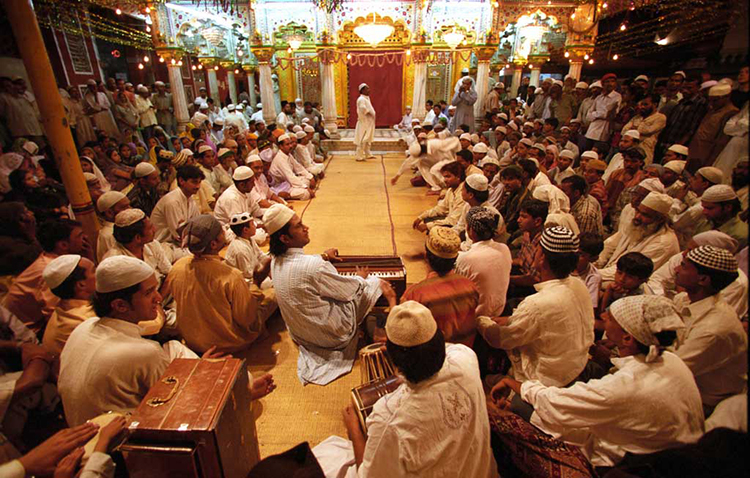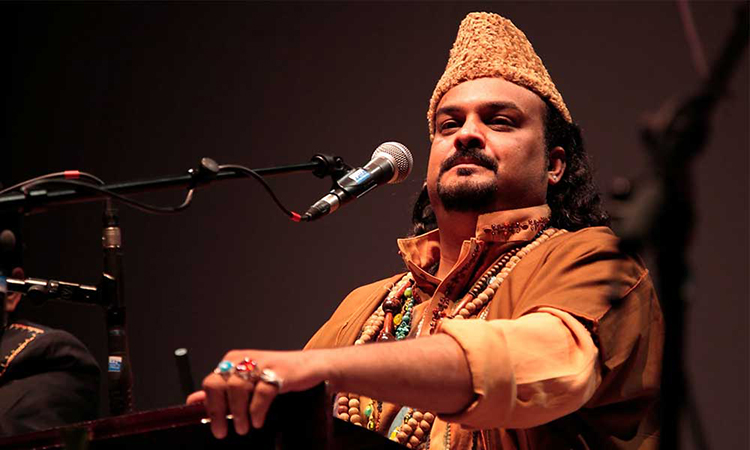Written by: Ahmed Lodhi
Posted on: June 24, 2016 | 
Ghulam Farid and Maqbool Sabri
In his famous Allegory of the Cave, Plato encapsulates the process of human enlightenment with a simple metaphor of freeing prisoners from a cave. The chained prisoners, lacking the ability to move their heads around, are faced with shadows of objects being moved behind them, casted on the cave wall by a massive fire at the back. For the prisoners, who cannot see the objects or the fire, the shadows on the wall constitute reality. Some prisoners, however, are then freed and exposed to the sights behind them and those outside the cave, being enlightened as a result.
In the syncretic religious context of South Asia, Qawwaali is a cherished institution that enlightens people about the veiled existence of God within every manifestation around them. Notions devoid of divine presence are redefined to trace intricate relation with God, reenacting the prisoners’ changing perceptions of reality upon being set free.
As a mode of mystical communication, Qawwaali was conceived in the Sultanate age of Delhi by the 13th Century CE Sufi scholar, Amir Khusrau, and institutionalized in his Chishti order by the 12 disciples who were trained in the art by the pioneer himself. Spreading across North India and Pakistan by the circus of spiritual and political migrations, the progenies of Khusrau’s disciples have emerged as the famed ‘qawwaal gharanay’ that bear the torch of qawwaali even eight centuries later.

The allegorical depth of the Sabri qawwaals however, would shy away from that of their contemporaries. While Aziz Mian mastered in presenting intoxication as closeness to God, and said more than 3,000 couplets in that metaphor, and Nusrat Fateh Ali felt at ease discussing the beauty of the Creator in the simile of feminine attractiveness, Ghulam Farid and Maqbool Sabri kept their distance from a similar, amorphous description of God. Instead, the brothers-duo produced structured and definitive masterpieces such as Bhar do Jholi, Tajdaar-e-Haram, and Ya Muhammed Nur-e-Mujassam, which addressed God and Muhammad unswervingly. These contrasting approaches can be understood in the mystical speculative thought as varying advocacies of wahdat al-wujud (unity of being) and wahdat al-shuhud (unity of witness). The Sabri gharana, seemingly leaning towards the latter ideology, consider any instance of unity between God and His creation a matter of individual assertion, leaving little room for allegorical qawwaali rendition.

With the second generation of Sabri gharana in Pakistan, qawwaali seeped into the popular culture of Pakistan. Previously restricted to gatherings of high culture, unless sighted in cinemas as part of movies, qawwaali was not taken out to the masses before the time of Amjad Farid Sabri – one of Ghulam Farid’s five sons, and the only one to hold up his legacy. Amjad transcended the barriers of class and religion, and performed at urban locales and rural melas, and Sunni shrines and Shi’i imambargahs with unvarying devotion and inexplicable humbleness. In addition to performing the exhilarating qawwaalis of his father and uncle, Amjad Sabri brought to the limelight soulful pieces of art including Zehra ki Shaadi, Kya Husayn Hai, and Moray Angna Moinuddun. A characteristic that launched Amjad so far ahead of other qawwaals, that for the longer part of his career one could not identify a weighty contemporary, was his openness to performing kalaam written and composed by, or for, others. Having an extensive list to decide from, Amjad selectively catered to the gathering’s mood and shout-out suggestions, involving people with just more than visual appeal.
As a Qawwaal who facilitates communication with the divine, Amjad enlightened many minds about the veiled existence of God. His choice of prisoners to unchain from the cave was not restrictive. Rather, Amjad offered this enlightening trip to all, without caring much about the resistance he was met with. Plato does not rule out the possibility of similar resistance from the prisoners who, in the triumph of reality perceived from mere shadows on the wall, are not willing to take the excursion outside. Instead, they feel the urge to avoid it by killing the one who is unchaining them. On 22nd June, 2016, Amjad Farid Sabri fell victim to a similar prisoner that he was trying to unchain.
You may also like: